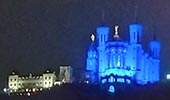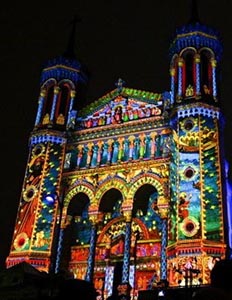The Lyonnais and 8th December
 Like me, every year thousands of Lyonnais and tourists admire the illuminations of the city of Lyon. They brave the cold to go out in the streets, nearly all turned into a big pedestrian zone. The origins of this festival of light are linked to the cult of the Virgin Mary and her sanctuary on the hill of Fourvière. This cult dates back to the time of the first Christians. In the year 140, the first bishop of Gaul and Lyon, Pothin, is said to have placed an image of the Virgin in the crypt of the church of Saint Nizier (the stained glass window of Saint Paul's Church commemorates this fact.)
Like me, every year thousands of Lyonnais and tourists admire the illuminations of the city of Lyon. They brave the cold to go out in the streets, nearly all turned into a big pedestrian zone. The origins of this festival of light are linked to the cult of the Virgin Mary and her sanctuary on the hill of Fourvière. This cult dates back to the time of the first Christians. In the year 140, the first bishop of Gaul and Lyon, Pothin, is said to have placed an image of the Virgin in the crypt of the church of Saint Nizier (the stained glass window of Saint Paul's Church commemorates this fact.)
In the Middle Ages, in the mid-12th century, a chapel dedicated to the Virgin Mary was built on the Fourvière hill: a location that dominates the city of Lyon. In the middle of the 17th century, the Aldermen and the Provost made a solemn vow to protect themselves from calamities such as cholera, invasions, plague: they vowed that if the plague disappeared they would erect 2 other statues to the Virgin, and they would go up to Fourvière each year to offer the sanctuary a golden coin and seven pounds of white wax. The epidemic ceased on 8th September, 1643. In 1720, another plague ravaged Marseille and the Rhone Valley once again, however It did not reach Lyon! The annual pilgrimage was made until the year 1789 but thereafter the pilgimage was only made sporadically.
 In the middle of the 19th century, a new bell tower was erected at the chapel of Fourvière and it was decided that a monumental statue of the Virgin should be placed on the top. The inauguration was planned for 8th September 1852 but unfortunately had to be postponed to 8th December 1852 due to severe floods. On 8th December, while a large crowd waited for this event and also participated in a grand religious celebration, a violent thunderstorm broke out around noon followed by a big storm all afternoon forcing the organizers to postpone the festivities to 12th December. In the evening of 8th December, at 6 p.m the storm ceased and the people of Lyon spontaneously installed small lanterns and all kinds of rudimentary lighting on their windows. The illuminations continued from 12th to 19th December 1852 and new illuminations appeared, even assisted by the religious and civil authorities.
In the middle of the 19th century, a new bell tower was erected at the chapel of Fourvière and it was decided that a monumental statue of the Virgin should be placed on the top. The inauguration was planned for 8th September 1852 but unfortunately had to be postponed to 8th December 1852 due to severe floods. On 8th December, while a large crowd waited for this event and also participated in a grand religious celebration, a violent thunderstorm broke out around noon followed by a big storm all afternoon forcing the organizers to postpone the festivities to 12th December. In the evening of 8th December, at 6 p.m the storm ceased and the people of Lyon spontaneously installed small lanterns and all kinds of rudimentary lighting on their windows. The illuminations continued from 12th to 19th December 1852 and new illuminations appeared, even assisted by the religious and civil authorities.
 From 1853 the celebration on 8th December became partly a religious function and also assumed a secular aspect. During the 1900s there were clashes between clerics and anticlerics. After the two World Wars these illuminations were no longer encouraged by the religious authorities. The tradition was revived in the 1980s. Approximately ten years later, the city of Lyon launched a Lighting Plan which aimed to illuminate public buildings to bring life to the city. This introduced the concept of the «Fête des Lumières» which is simultaneously a religious festival, a popular festival and an institutional festival, The 8th December has become a tourist event that will gain in fame and attendance, with the participation of companies demonstrating their great technological know-how in the lighting up of 267 sites, including 120 buildings of significance, 20 facades and 20 streets.
From 1853 the celebration on 8th December became partly a religious function and also assumed a secular aspect. During the 1900s there were clashes between clerics and anticlerics. After the two World Wars these illuminations were no longer encouraged by the religious authorities. The tradition was revived in the 1980s. Approximately ten years later, the city of Lyon launched a Lighting Plan which aimed to illuminate public buildings to bring life to the city. This introduced the concept of the «Fête des Lumières» which is simultaneously a religious festival, a popular festival and an institutional festival, The 8th December has become a tourist event that will gain in fame and attendance, with the participation of companies demonstrating their great technological know-how in the lighting up of 267 sites, including 120 buildings of significance, 20 facades and 20 streets.
This is an event to be witnessed and appreciated at least once in a lifetime.
Solange Paccoud
Association de Lyon
France


